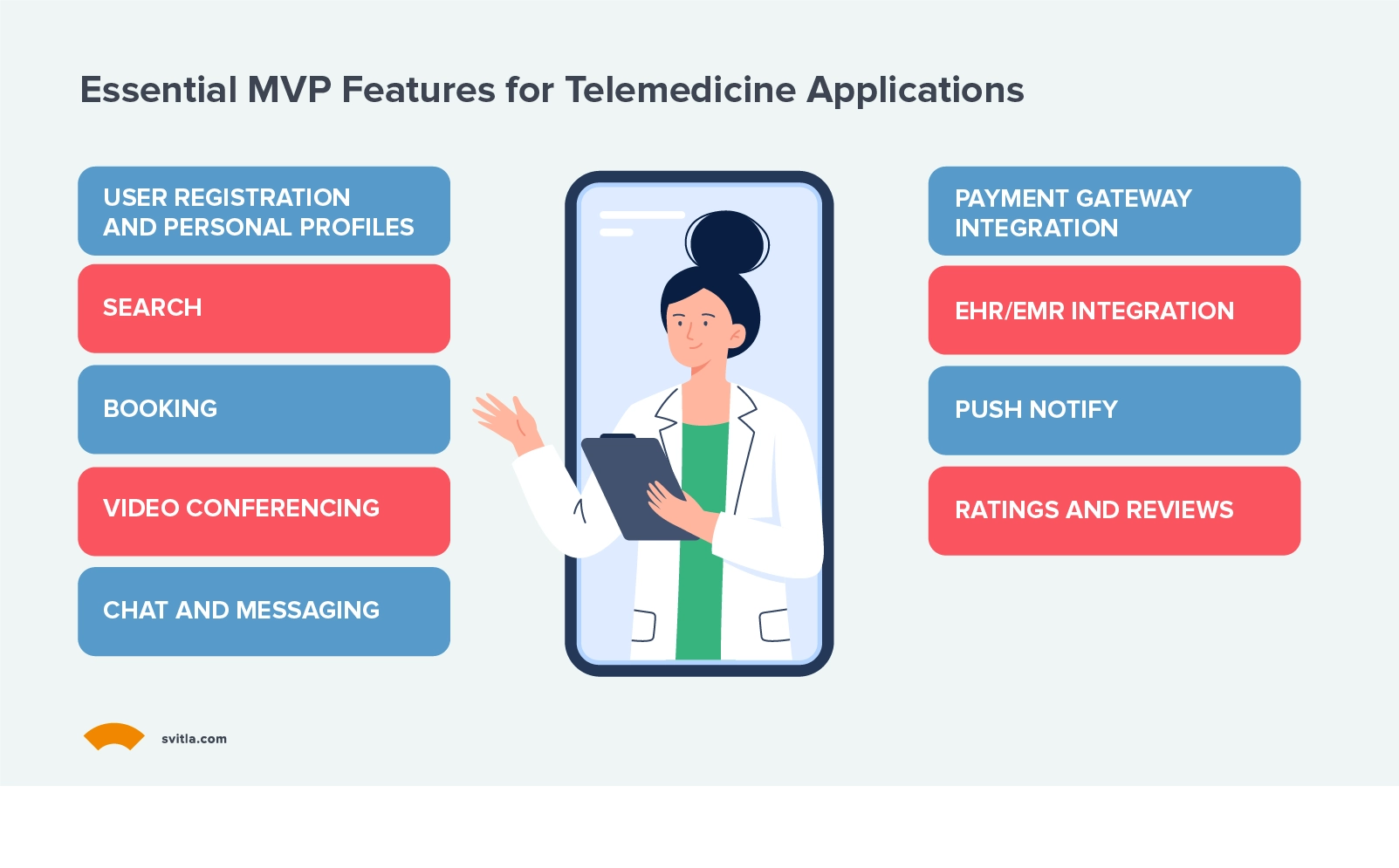In recent years, telemedicine app development has emerged as a transformative force in healthcare, reshaping how medical services are delivered and accessed. This shift towards telemedicine app development is not just a fleeting trend but a response to a changing healthcare landscape, where convenience, accessibility, and efficiency have become paramount.
The popularity of telemedicine app development can be attributed to several key factors, each significantly stimulating its widespread adoption. Firstly, technological advancements have paved the way for more sophisticated and user-friendly telemedicine solutions. The integration of high-speed internet, advanced mobile technologies, and innovative software applications has made virtual consultations and remote patient monitoring more feasible and effective.
Secondly, the changing patient expectations are also driving the growth of telemedicine. Today's healthcare consumers increasingly seek convenient, on-demand medical services that align with their digital lifestyles. Telemedicine apps meet this need by allowing patients to consult with healthcare professionals from their homes, reducing the need for in-person visits.
Moreover, the recent global health challenges have accelerated the adoption of telemedicine solutions. The necessity to provide healthcare services amidst restrictions on physical movement highlighted the critical role of telemedicine in ensuring uninterrupted healthcare access. This situation fostered a more rapid acceptance and implementation of telehealth solutions by healthcare providers and patients.
As a result, telemedicine app development solutions have become integral to this digital healthcare revolution. These apps are not just tools for virtual consultations; they are comprehensive platforms that enhance patient engagement, streamline healthcare delivery, and foster a collaborative relationship between patients and healthcare providers.
This article will explore the intricacies of telemedicine app development, delving into the features, challenges, and best practices that define successful telemedicine solutions. Whether you are a healthcare provider, app developer, or entrepreneur, understanding the dynamics of telemedicine app development is crucial in this era of digital healthcare transformation.
Key Players in the Telemedicine App Development Services Market
The telemedicine market is brimming with innovative players, each contributing unique features and designs that set them apart. Here’s a look at some key players in the telemedicine market, their groundbreaking features, the factors behind their popularity, and the distinctive aspects of their UI/UX design.
Teladoc Health
- Groundbreaking features: Teladoc Health offers various services, including virtual visits, mental health consultations, and chronic care management.
- Popularity: Its popularity surged due to its extensive network of healthcare professionals and ability to provide 24/7 access to medical care.
- UI/UX design: The app is known for its intuitive interface, easy navigation, and clear communication, making virtual consultations stress-free for patients of all ages.
MDLive
- Groundbreaking features: MDLive stands out with its virtual primary care, mental health services, and dermatology consultations.
- Popularity: It gained traction for its quick appointment scheduling and immediate access to healthcare professionals.
- UI/UX design: The platform’s user-friendly design focuses on a seamless experience from appointment booking to consultation.
Amwell
- Groundbreaking features: Amwell offers video consultations and telehealth solutions for hospitals and insurers. It also provides urgent care services online.
- Popularity: Amwell became popular for its high-quality video consultations and integration with various health insurance plans.
- UI/UX design: The app emphasizes ease of use, with clear options for different types of care and straightforward navigation.
Doctor On Demand
- Groundbreaking features: This platform is known for its comprehensive approach, offering urgent care, behavioral health, preventive health, and chronic care.
- Popularity: Its popularity stems from its holistic healthcare approach and the inclusion of preventive and chronic care.
- UI/UX design: Doctor On Demand features a clean, engaging design with an empathetic tone, enhancing the user experience.
PlushCare
- Groundbreaking features: PlushCare is recognized for its primary care and mental health services, along with its ability to prescribe medications and order lab tests.
- Popularity: It gained recognition for its ease of prescription refills and seamless integration with pharmacies.
- UI/UX design: The app’s simple, clutter-free interface allows for easy navigation, appointment setting, and access to medical records.
MVP Features for Telemedicine Applications: An Overview
Telemedicine app development hinges on incorporating Minimum Viable Product (MVP) features. These features are essential in ensuring the app effectively meets the core needs of its users – both patients and healthcare providers. Here’s an overview of the essential MVP features for telemedicine applications.
User Registration and Profiles
The app should facilitate easy user registration and profile setup. For patients, profiles may include personal information, medical history, and insurance details. For doctors, profiles may encompass credentials, specialties, and availability.
Search Functionality
A search function allows patients to find suitable healthcare providers based on factors like specialty, location, ratings, or insurance acceptance.
Appointment Scheduling
An intuitive appointment scheduling feature is essential. This feature should allow patients to book, reschedule, or cancel appointments. It should also enable providers to manage their schedules effectively.
Video Conferencing
High-quality video conferencing is the backbone of a telemedicine app. This feature should provide a seamless and secure platform for virtual consultations between patients and healthcare providers.
Chat and Messaging
Secure in-app messaging allows for communication between patients and doctors. This feature can be used for follow-ups, clarification of medical advice, or preliminary discussions before a video call.
Prescription Management
A feature for managing prescriptions, which enables providers to send e-prescriptions directly to pharmacies, can greatly enhance the convenience for patients.
Payment Gateway Integration
Integrating a secure payment system is essential for processing consultation fees. The system should support multiple payment methods and be compliant with financial regulations.
EHR/EMR Integration
Integrating Electronic Health Records (EHR) or Electronic Medical Records (EMR) systems is crucial for maintaining comprehensive patient records. This integration allows for a better-informed and more efficient consultation process.
Push Notifications
Push notifications are essential for keeping users engaged and informed. They can be used for appointment reminders, prescription notifications, or general health tips.
Ratings and Reviews
A feature for patients to rate and review their consultations can help maintain high service quality and assist other patients in making informed choices.
Data Security and Compliance
Ensuring data security and compliance with health care regulations like HIPAA is non-negotiable. The app must include features that safeguard patient information and comply with legal standards.

Monetization Strategies for Telemedicine Applications
Capitalizing on telemedicine applications is crucial for sustaining and growing these digital health solutions. As the telemedicine app development market expands, understanding and implementing effective monetization strategies is key for developers, healthcare providers, and entrepreneurs. Here are several approaches to monetizing telemedicine applications effectively:
- Subscription models: One of the most common monetization strategies is the subscription model. Here, users – patients or healthcare providers – pay a regular fee to access the app’s services. This model can offer various tiers, each providing different access levels or features.
- Pay-per-consultation fees: Implementing a pay-per-consultation fee structure can attract users who prefer a pay-as-you-go approach. This model is straightforward and transparent, where users are charged based on the number of consultations or the duration of each session.
- Freemium model: The freemium model offers basic services for free while charging for advanced features or functionalities. This approach can initially attract a larger user base, potentially converting free users into paying customers as they seek more advanced features.
- Partnerships with healthcare providers: Establishing partnerships with hospitals, clinics, and healthcare networks can provide a steady revenue stream. These partnerships might involve offering the telemedicine app as a platform for healthcare providers to extend their services digitally.
- Integration with health insurance plans: Collaborating with insurance companies to include telemedicine services in health insurance plans can be a lucrative strategy. This approach broadens the user base and aligns with the growing trend of insurance companies supporting digital health services.
- In-app advertisements: While not as prevalent in healthcare apps due to privacy concerns, in-app advertisements can be a source of revenue, especially for free app versions. If opting for this route, it’s crucial to ensure that advertisements are relevant and non-intrusive.
- Offering additional services: Additional services like health trackers, wellness programs, or personalized health reports can add value for users and create additional revenue streams.
- White-label solutions: Offering the telemedicine platform as a white-label solution to other businesses can be profitable. This involves selling a customizable version of the app to other companies who can brand it as their own.

Navigating Challenges in Building a Telemedicine App
Developing a successful telemedicine app involves navigating myriad challenges, ranging from regulatory compliance to ensuring accessibility for all patients. Understanding and addressing these challenges is critical for any telemedicine app to be effective and widely adopted. Here are key considerations to keep in mind:
Adherence to Local and Security Regulations
Navigating local healthcare regulations and security standards, such as HIPAA (Health Insurance Portability and Accountability Act) in the United States, is crucial. These regulations govern patient data privacy and security, and non-compliance can lead to legal repercussions and loss of trust.
Building a Loyal User Base
Establishing a loyal user base is essential for the app's long-term success. This requires an intuitive and user-friendly design, consistent reliability, effective marketing strategies, and excellent customer support.
Ensuring Broad Accessibility
A significant challenge is ensuring the app is accessible to all patients, including those with limited internet access or without advanced gadgets. Solutions might include optimizing the app for low-bandwidth environments or offering basic functionalities that can run on lower-end devices.
Integration with Existing Healthcare Systems
The app should ideally integrate seamlessly with existing healthcare systems and EHRs (Electronic Health Records). This integration can pose technical challenges but is vital for streamlined workflows and continuity of care.
Dealing with Technological Disparities
Addressing the technological disparity among patients, especially the elderly or those less familiar with digital technology, is crucial. This might involve creating user interfaces that are easy to navigate for all age groups and providing additional support or tutorials.
Maintaining Data Security and Privacy
Ensuring the highest standards of data security and privacy is non-negotiable. Implementing robust encryption methods, secure data storage solutions, and regular security audits are essential to protect sensitive patient information.
Providing Reliable and High-Quality Services
The app must provide reliable and high-quality telemedicine services. This includes minimal downtime, high-quality video and audio for consultations, and quick and responsive customer service.
Cultural and Language Barriers
Overcoming cultural and language barriers is important in making the app universally accessible. Offering multilingual support and considering cultural sensitivities can enhance user experience and acceptance.
Cost-Effectiveness
Ensuring that the app’s development and maintenance costs remain within budget while offering affordable services to users is a challenging balance to strike.
User Education and Trust
Educating users about the benefits and usage of telemedicine and gaining their trust is essential for adoption. This involves clear communication, user education campaigns, and transparency in operations.
Trends Shaping the Future of Telemedicine and TeleHealth
The field of telemedicine app development is rapidly evolving, driven by technological innovations and changing healthcare needs. As we move into 2023 and beyond, several key trends are shaping the future of telemedicine, offering exciting possibilities for healthcare organizations and patients alike. Here's a look at five significant trends in telemedicine:
Integration of Advanced Technologies like Virtual Reality
The use of virtual reality (VR) in telemedicine is gaining traction. VR technology is being explored for patient care applications, such as in therapy sessions, pain management, and rehabilitation. This immersive technology enhances patient engagement and offers new avenues for treatment.
Telemedicine App Development Becoming Standard for Healthcare Providers
The development of telemedicine apps is rapidly becoming a norm for hospitals and healthcare practitioners. These apps are essential tools in expanding access to healthcare services, especially in areas with limited medical facilities. They offer convenience and accessibility, bringing healthcare to patients’ fingertips.
Rise of Artificial Intelligence in Patient Care
Artificial Intelligence (AI) is increasingly being integrated into telemedicine platforms. AI can analyze patient data, diagnose, personalize treatment plans, and predict health risks. This technology is revolutionizing patient care by making it more efficient and data-driven.
Utilization of Augmented Reality for Diagnosis and Testing
Augmented Reality (AR) is emerging as a valuable tool in telemedicine, particularly in diagnostics and testing. AR can aid healthcare professionals in visualizing and interpreting medical conditions, enhancing the accuracy of diagnoses and treatment plans.
Natural Language Processing (NLP) Enhancing Patient Consultation Experience
NLP technologies are being used to improve patient experiences during online consultations. NLP can facilitate smoother communication, interpret patient input more accurately, and even assist in analyzing clinical documentation, making consultations more efficient and effective.
As telemedicine continues to evolve, these trends point towards a future where early diagnosis, enhanced patient experiences, and wider access to healthcare are the norms. With ongoing technological advancements and increasing adoption by healthcare providers, telemedicine is set to transform healthcare delivery in profound ways.





